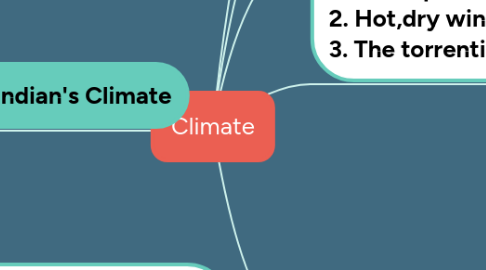
1. Factors Affecting Indian's Climate
1.1. Altitude
1.1.1. As the Tropic of Cancer passes through the middle of the country, India experiences both tropical and sub-tropical climate.
1.2. Altitude
1.2.1. The temperature and density of air decreases with the increase in altitude and vice-versa
1.3. Pressure and winds
1.3.1. The movement and direction of winds influence India's climate which experiences heavy rainfall due to the movement of high-pressure winds to the low-pressure belt over the Indian subcontinent.
1.4. Distance from the sea
1.4.1. As the distance from the sea increases, temperature rises and vice-versa
1.5. Ocean Currents
1.5.1. While warm ocean currents increase the temperature of the areas surrounding the ocean, cold ocean currents have a cooling effect on the coastal areas.
1.6. Relief
2. While the windward side of the mountains experiences rainfall, the leeward side remains dry due to the lack of natural barrier
3. Different Seasons Of India
3.1. The Cold Weather Season (Winters)
3.1.1. From mid November to February
3.1.1.1. Between 24°-25°C in southern India, between 10°-15°C in nothern parts of India
3.1.2. 1. Remains mostly dry 2. Cyclonic disturbances which enter India from the west and the north-east cause rainfall in the northern plains. 3. The rainfall is beneficial for rabi crops
3.2. The Hot Weather
3.2.1. March to May
3.2.1.1. 38-45°C, slightly lower temperatures in coastal areas, cool weather in mountains
3.2.1.2. 1. The low-pressure belt over the Indian subcontinent attracts the south-east trade winds. 2. These winds pick up moisture from the Indian ocean and enter India as the south-west monsoon winds. 3. The period is marked by heavy rainfall in the north-eastern parts as well as the Western Ghats.
3.3. The Rainy Season
3.3.1. June to mid-September
3.3.1.1. 27°-35°C
3.4. The Transition Season (Post-monsoon)
3.4.1. October-November
3.4.1.1. 20°-34°C
3.4.2. 1. This period marks the withdrawal of monsoon winds from the mainland. 2. The low-pressure belt shifts to the Bay of Bengal which leads to the formation of cyclones over the Andaman Sea. 3. These cyclones cause heavy rainfall in the deltas of the Godavari, Krishna and Kaveri rivers.
